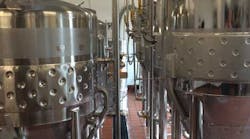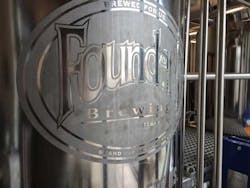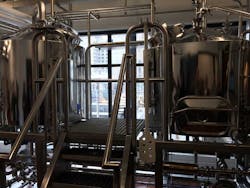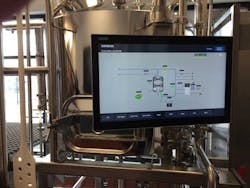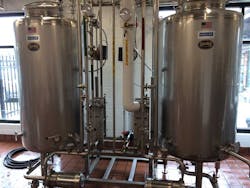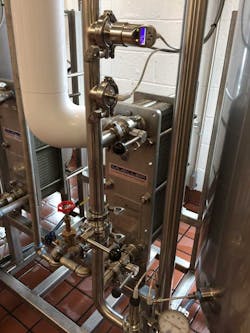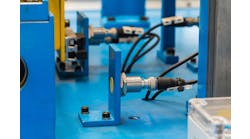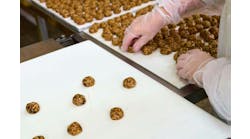Well-balanced, unremarkable beers don’t attract new customers, and they certainly don’t win awards. It takes complex, in-your-face ales with huge aromatics, big body and lots of flavor to make waves in the competitive brewing industry. And you could even earn some awards, such as 13 medals—six from the World Beer Cup, four European Beer Star and three Great American Beer Festival—for your efforts.
Founders Brewing, founded in Grand Rapids, Michigan, in 1997, has facilities in two cities. With two decades of brewing experience and expertise under its belts, Founders Brewing decided to expand its operations outside of Grand Rapids, where its primary brewery and tap room have become important parts of the local landscape and culture. “We wanted to build an R&D brewhouse where we could try new beers to test in a different market,” says Patrick Zambon, controls engineer at Founders. “The idea for a tap room with a four-barrel brewhouse in Detroit started in the summer of 2017, and it was finished around the end of November (Figure 1).”
Figure 1: The idea for a tap room with a four-barrel brewhouse in Detroit started in the summer of 2017.
Founders worked with Siemens and other companies to automate the Detroit brewhouse using a Simatic-S7-1500 control system and G120 variable-frequency drives (VFDs) for material flow. The brewer continues to run much of the process in manual mode, but has the ability to automate, which allows for a more repeatable end product. The brewery also has a complete electrical infrastructure from Siemens.
The resulting brewhouse puts out roughly two to three new offerings per week from Brewer Andrew Veenhoven, who shares his creations with patrons in the accompanying tap room in the heart of downton Detroit.
“We have a two-vessel brewhouse with five fermenters and a bright beer tank,” says Zambon (Figure 2). “We have the ability to add more fermenters, which will enable us to consistently brew three times a week.”
Figure 2: The four-barrel, two-vessel brewhouse includes the mash/lauter tun (right) and kettle/whirlpool.
Where the brews are
Zambon worked with Ed Montgomery, Siemens food & beverage industry manager for brewing, wine and spirits, along with Matt Klein, senior automation specialist at Electro-Matic Products, to spec out the gear for the project at the Detroit location.
“Our company likes to make a decision and move fast,” explains Zambon. “We started designing in July. We started implementing the end of September. In October we were commissioning, and we were live in November.”
The brewing system in Founders’ Detroit facility is controlled by a Siemens Simatic-S7-1500 system, which connects to the Siemens TIA Portal brewing platform. “All of our process control system and the six variable-frequency drives are Siemens,” explains Zambon.
The TIA Portal is exclusive to the Detroit brewery; however, Siemens PLCs power all process control in both Grand Rapids locations. “All of our pump controls and PIDs are right there,” says Zambon. “We use it for a lot of speed control and temperature. It gives the brewer flexibility and consistency.”
The Founders Brewing system in Detroit is also a relatively manual process. Depending on what beer he wants to brew, Veenhoven mills in whatever he wants and then manually mixes the grain. “Because it’s a manual mash/lauter tun, the raking and the resting are all done in the brewer’s head,” explains Zambon. “He decides when he wants to start and stop the mixing. If we had more automation on the brewhouse, we could use it for more recipe management. Because of our setup, we’re kind of limited on automation.”
Strike while it’s hot
Strike temperature and knockout temperature are critical measurements in the brewing process. While many breweries use a three- or four-vessel brewing system, Founders has reduced the process footprint and built a skid that utilizes a two-vessel system for its Detroit R&D brewhouse.
Figure 3: Aside from the manual steps done in Brewer Andrew Veenhoven’s head, the process is monitored and controlled via the automated technology.
“The first vessel is the mash/lauter tun, where hot water is mixed with grain and then filters through the grain bed,” says Zambon. “The strike temperature is the temperature of the water when it hits the grains for the first time,” explains Zambon. That’s all controlled through TIA Portal (Figure 3). “Knowing how much water you use is also important. We’re using Siemens magnetic flow sensors (mag meters) to capture that data. That’s critical for repeatability (Figure 4).”
Figure 4: The mash/lauter tun is equipped with pump and magnetic flow sensors (mag meters) to capture data that is critical for repeatability.
The second vessel is a kettle whirlpool. The kettle is where you bring your wort to a boil, and after about an hour you would transfer to a whirlpool. Since it’s the same vessel, we spin the wort through the kettle to bring the sediment to the center. Then we transfer to a cylindrical-conical tank, known as ‘knocking out,’and leave the sediment behind (Figure 5).”
Figure 5: After the wort is spun through the kettle to bring the sediment to the center, it’s transferred to a cylindrical-conical tank. This process is known as “knocking out”and leaves the sediment behind.
The water skid includes sensing devices for collecting process variables used in proportional-integral-derivative (PID) control loops for the hot and cold water (Figure 6). “We run PIDs for pressure and temperature on each tank,” says Zambon. “We can ensure hitting our strike temperature each time. That’s one of the main functions. We use Siemens' PS2 valve positioner for the PID loop. That’s how we’re manipulating the temperature.”
Figure 6: The hot-and-cold-water skid includes process-variable measurement devices, controllers, stainless-steel heat exchangers and stainless-steel pumps.
The skid is equipped with Endress+Hauser pressure sensors, as well as resistance temperature detectors (RTDs) from ifm efector (Figure 7). “I was very strategic about what I wanted in Detroit because we do not have any maintenance personnel, so our brewer has to take care of everything,” explains Zambon. “I went Endress+Hauser because it’s very robust. The ifm RTDs are easy to troubleshoot. With a meter, our brewer can determine if an RTD is good or bad. All instruments are quick-disconnect, and all process connections are tri-clamp; this gives Andrew (Veenhoven) the ability to be a one-man show.”
Figure 7: The skid is equipped with stainless-steel heat exchanger, dry-run point switch, pressure transducers and resistance temperature detectors (RTDs) to record critical measurements.
